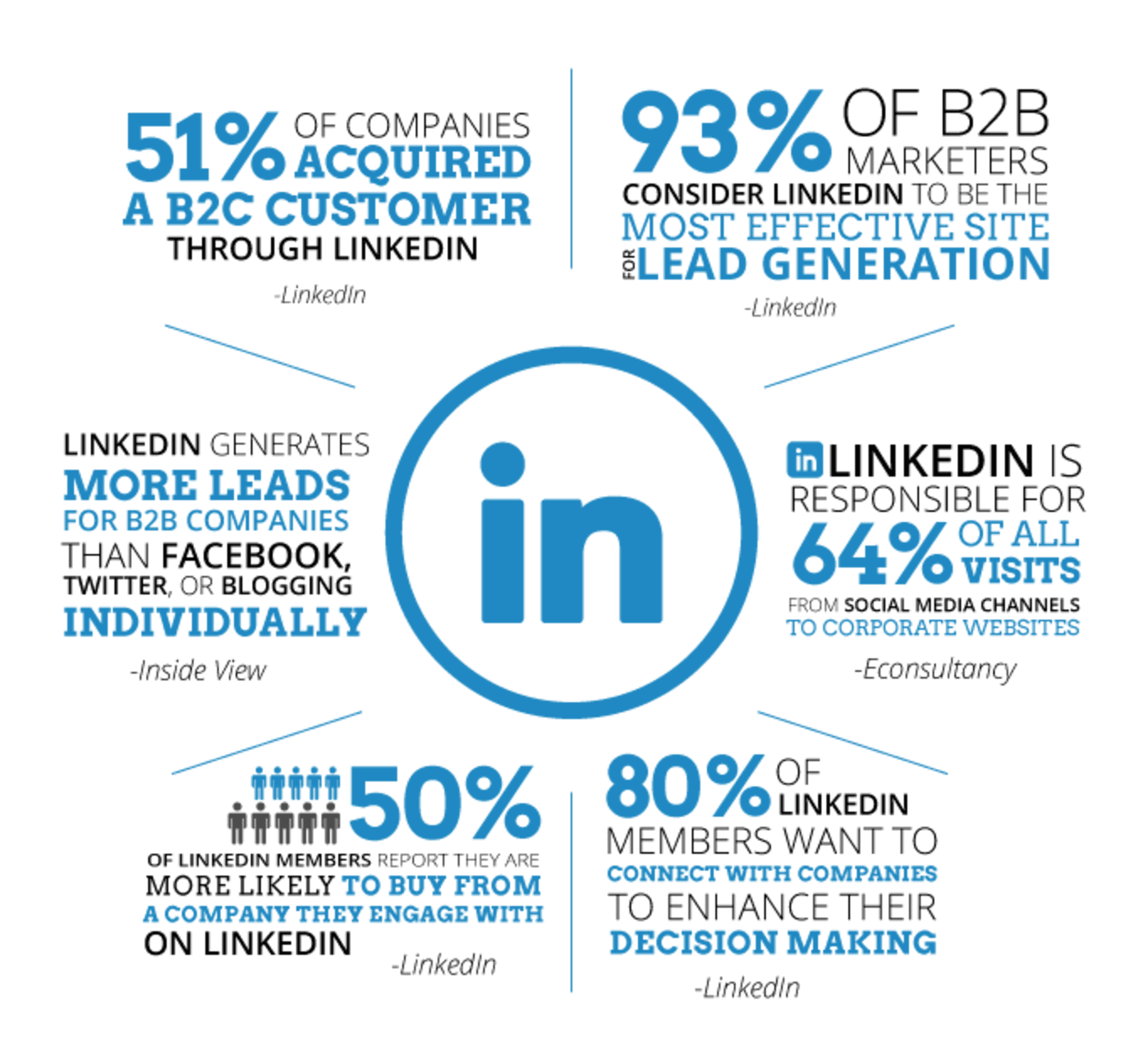 If I asked you what’s the most important professional networking tool, you’d probably answer, “LinkedIn.”And you’d be right: As Fortune points out, the website has 500 million users. But what’s equally interesting for B2B marketers is that LinkedIn also lists information about more than nine million organizations — data about everything from location and company size to brands and initiatives.Just take a moment to really appreciate the enormity of those statistics. Clearly, if you’re looking to make connections for B2B lead nurturing, LinkedIn is a treasure trove of information both about companies and the decision makers who run them.
If I asked you what’s the most important professional networking tool, you’d probably answer, “LinkedIn.”And you’d be right: As Fortune points out, the website has 500 million users. But what’s equally interesting for B2B marketers is that LinkedIn also lists information about more than nine million organizations — data about everything from location and company size to brands and initiatives.Just take a moment to really appreciate the enormity of those statistics. Clearly, if you’re looking to make connections for B2B lead nurturing, LinkedIn is a treasure trove of information both about companies and the decision makers who run them.
Who Uses LinkedIn for Lead Nurturing and Why?
Knowing this, it should come as no surprise that according to the 2018 Social Media Marketing Report from Social Media Examiner, an astounding 79 percent of B2B marketers use LinkedIn for lead nurturing. And with more and more organizations entering the global marketplace, that number could even increase, since LinkedIn allows you to connect effortlessly with people and companies across the globe.
So why exactly are so many B2B marketers using LinkedIn? There are several reasons.
First, the platform offers an easy-to-use, convenient way to build connections and expand your network — both of which are crucial aspects of lead generation. Second, it allows you to build credibility by sharing your expertise. And third, it enables you to prospect for potential business partnerships.
Why You Should Hyper Focus Your Prospecting Efforts
What’s so important to understand for lead nurturing on LinkedIn is that simply casting a giant net to see who bites isn’t the most efficient use of your time and resources. Instead, hyper focusing your prospecting efforts to target the kind of business that matches your customer profile is much more effective.
Think about it: If you’re on a mission to simply get as many contacts as possible, how many of those contacts are likely to really be in the market for the type of product or service you’re selling?
At the same time, if you post content on LinkedIn two to three times a week, how many of those contacts — dealing with their busy, information-overloaded days — do you think will actually click on that content in their feed?Unfortunately, it’s not likely to be that many. Why not? Because the information might not be relevant to them.A better approach to finding and nurturing leads is to choose quality over quantity. A high-quality lead is more likely to interact with you, derive value from the information and insights you share, and ultimately be interested in potentially purchasing your product or service.
And here’s the kicker: You can find high-quality leads by hyper focusing your prospecting efforts on leads who possess the characteristics of your target market.
How You Can Leverage LinkedIn to Hyper Focus Your Prospecting Efforts
Now you know you need to hyper focus your prospecting efforts, how do you go about doing this?
Interestingly, you have to begin with yourself and your own company. Why? The reason is simple: Anybody who wants to engage with you — because you’ve viewed their profile, sent them an invite or provided insights in a group — is bound to research you. That means you need to be prepared to make the right impression.
Start by enhancing your profile page. Make sure you have a professional photo, an eye-catching headline and an engaging summary. It’s also advisable to include any professional accomplishments, as well as mentions of projects you’ve worked on and any content you’ve published on LinkedIn or elsewhere.

You should also optimize your company page. You want to grab the viewer’s attention, so make your header image pop and provide a clear, concise company description. In addition, create a memorable tagline. This helps communicate your brand so your leads immediately know what you do and how you do it.
Now it’s time to look for leads that fall within your target market. You can do this by using LinkedIn’s powerful search feature. You can search on keyword, name, past and current company, location, connection and industry. If you have a Sales Navigator membership, you can perform an advanced search, which allows you to apply more than 30 filters regarding profile, role and tenure, company and more.
Obviously, the more you narrow down your search to match your target customer, the more hyper focused your prospecting efforts will be.
For example, if you sell accounting software solutions for small businesses such as cafés, eateries and restaurants, you could do a search for business owners in New England — but this will give you thousands of results. It’s far more effective to target business owners in the hospitality industry who have around 20 employees. Moreover, if they’re in your circle of connections, you can ask a mutual connection to introduce you — and that’s always preferable to “cold calling.”
Another way to find leads is to participate in groups your target customers might frequent and where you can contribute in an insightful way. Think, for instance, of groups for entrepreneurs, small businesses and startups — anywhere your target audience might go for insights and advice that you can provide.
You can also start your own group to share your expertise and build a community. For example, at Aliste Marketing, we have our own group called Marketing for Business Owners, where members can connect with other business owners, ask for advice, participate in discussions and gain access to marketing resources they can implement in their companies. Note that in general, it’s best to use your group to be truly helpful to others — not simply to market your own product or services.

Regardless of how you acquire your leads, you also need to nurture them in a hyper focused manner. That means generating and sharing informative, insightful content that’s actually helpful to each specific person or group.
For example, if you’ve recently connected with a new lead via a group and that person asked a question about certain tax rules in accounting, you could send them a message with a link to an article about the topic. You can also post the link in the group, which would help you gain more visibility amongst other potential leads.
In addition, you can generate your own content that addresses specific pain points of your target audience in a knowledgeable, informative manner. Simply write an article and publish it to the Articles section of your profile, and it will be shared with your connections in their news feeds. Now, since you’ve been hyper focusing your prospecting efforts, the chances of a lead reading the article become much greater. As a result, you’ll improve your standing as a thought leader — and improve your chances of leads coming to you to do business.
Hyper Focused Prospecting Efforts Can Result in a Higher ROI
When it comes to lead nurturing, hyper focusing your prospecting efforts might require more preparation and research. However, since you’re providing helpful advice to professionals who actually need it, your efforts can have a higher ROI because those same professionals are more likely to seek you out when they’re in the market for a product or service like the one you provide.




